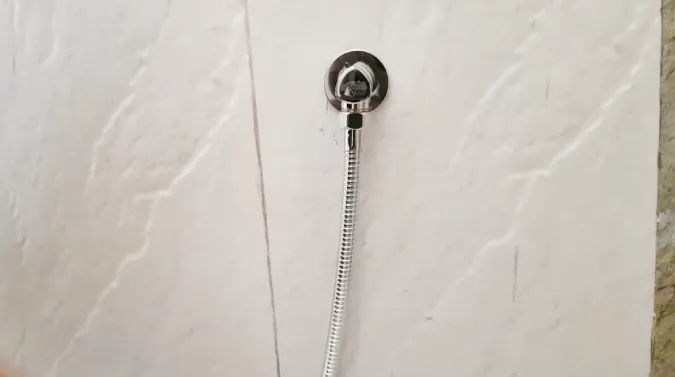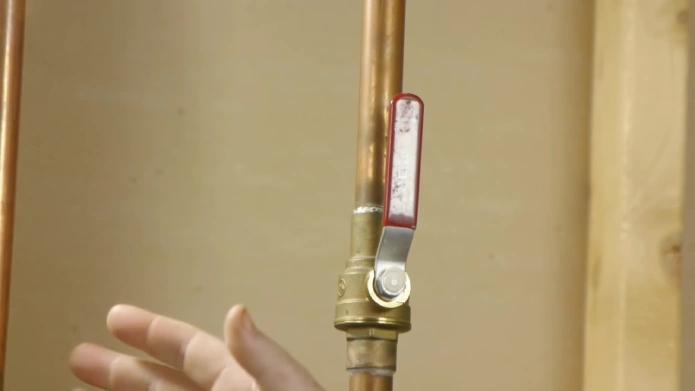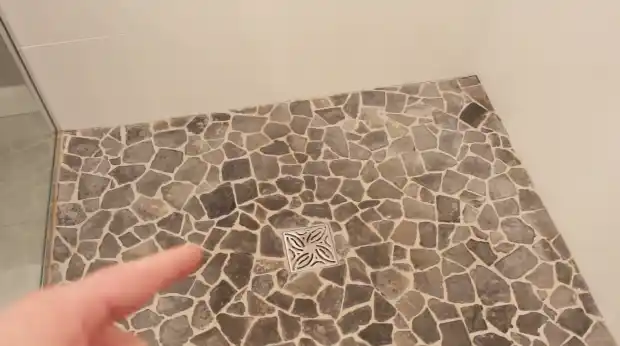Last Updated on May 23, 2023
Taking a shower daily is an important part of our lives, but few consider the science behind it. Believe it or not, there’s some interesting history and facts surrounding your morning (and evening) ritual.
Shower valves are the dynamic duo of any shower system, allowing you to customize your water flow and temperature. This awesome feature not only gives you control over how much water is released from the head. It also grants a luxurious level of comfort that makes every shower experience even more relaxing.
Are you curious to find out how your showers are affected by something so small? Flow restrictors in shower valves might be unknown to many, but they play an important role in our daily bathing experiences. Dive into the hidden world of flow restrictors and see why this seemingly insignificant piece makes a big difference.
Do Shower Valves Have Flow Restrictors: Important Reasons

1. To Reduce Water Usage and Increase Efficiency
Flow restrictors are designed to reduce water consumption and increase efficiency, allowing for more efficient operation of plumbing fixtures. These devices work by limiting the amount of water allowed to pass through a pipe at any time.
This helps reduce water waste and increase efficiency by reducing the pressure needed to move water through the system. Flow restrictors can help consumers save money on their monthly bills by helping to reduce the amount of energy needed to operate the plumbing system.
Flow restrictors keep plumbing systems safe. They stop too much pressure or sudden surges that can lead to leaks. This helps protect the system from damage.
Installing flow restrictors can help people follow the rules. It helps conserve resources and makes sure that people use them wisely. This helps us be sustainable and follow the standards set by the government.
2. To Comply with Environmental Regulations and Standards
Having a flow restrictor in a plumbing system design is an important part of meeting environmental regulations and standards. These devices help us save water. This saves important resources like clean drinking water. It also helps the environment.
Flow restrictors are great for households and businesses because they help reduce the amount of wasted water. That means you won’t have to pay extra fees from local water authorities due to high wastewater treatment costs.
Installing flow restrictors is a great way to make sure you’re following city building codes and conserving resources like fresh water. On top of that, it can help avoid extra expenses resulting from high sewage disposal costs.
3. To Produce a More Consistent Spray Pattern and Pressure
Flow restrictors are great because they help create consistent pressure and spray patterns throughout a system. This means you don’t need to worry about the damage that can happen when too much pressure builds up in the plumbing.
It can cause leaks and other problems. Flow restrictors help keep your plumbing system’s pressure and spray patterns even. This stops any unexpected damage from happening. Pipes help control the amount of water going to different places.
They make sure that all the pipes connected to the same line get an equal amount of pressure. Having better control over the performance helps us ensure that everything works without any unexpected peaks or drops in pressure.
This prevents damage or disruption within the system. Using these devices helps the environment. It makes the pumps work less hard, which means they don’t use up as much energy. This saves money on utility bills in the long run.
Commonly Used Flow Restrictor Materials and Configurations

1. Conventional Aerator Inserts with Calibrated Orifices
Common flow restrictor materials used in calibrated insert aerators are generally stainless steel, aluminum, plastic, brass, and ceramic. Stainless steel is the most common of these materials due to its high corrosion resistance and strength.
It is also lightweight and cost-effective when compared to other metals and alloys. Aluminum is also a popular material choice as it is strong yet lightweight and resistant to corrosion. Sometimes plastic parts can be used instead of metal pieces. They can be cheaper and might do the job better.
Brass has high malleability and good fatigue strength, making it well-suited for applications where flexibility is desired. Ceramic components are ideal for aerators where fine flow control is needed, but strength isn’t necessarily a concern.
2. Self-Cleaning Aerators Made From Silicon or Polymer Ceramic Materials
Silicon or polymer ceramic self-cleaning aerators use nozzles and ports. These create a flow of water from the source. The pattern is designed to be optimal for the incoming water. Nozzles come in many shapes and sizes.
Slit jets, flat jets, beveled jets, disc jets, fan jets, reverse taper slots, adjustable discs/orifices, cone jets, and curved slots/nozzles are some of the most popular types. Flow restrictors are made from different materials, like PVC, PP, PEEK, PEK, PC, PMMA, and TPE.
PVC and PP are types of plastic. PEEK and PEK are both copolymers materials. PC is a type of plastic, too, and PMMA is acrylic. Lastly, TPE is a thermoplastic elastomer material. Additionally, bronze or other metals may be employed depending on the specific application requirements.
3. Integrated Thermally Balanced Cartridge Design with Variable Adjustment Ring
Integrated thermally balanced cartridge designs have stainless steel bodies. They also have different internal flow restrictors. Examples include orifice plates with adjustable or fixed positioning, needle valves, spool valves, butterfly valves, ball valves, gate valves, and poppet valves.
Check valves, pressure relief valves, and flow diverters are internal flow restrictors used in these designs. Flow restrictors are often made from stainless steel alloys like 304L SS and 316L SS or plastics such as PTFE and PVDF.
These materials can withstand harsh chemicals and high temperatures. Brass is often used for parts that hold pressure. Other materials can be used, too, depending on what is needed, like performance goals, temperature ratings, etc.
Reasons Why Some High-End Valves do Not Include Flow Restrictors

1. To Support Maximum Available Water Pressure Output
There are special valves that can handle a lot of water pressure. They don’t need flow restrictors to control the pressure because they are designed for the highest output. It is important to have a strong and steady spray pattern in certain places. Examples include commercial kitchens and group showers.
Without the flow restrictor, these valves can deliver much higher pressures than those with the restrictor installed. This increased pressure also means that the sprays are more powerful and can reach further distances, allowing for greater coverage in larger spaces.
In addition to supporting higher outputs, the absence of a flow restrictor also helps reduce vibration throughout the system. It can provide more consistent temperature control when using water heater valves.
2. To Provide Higher Quality Sprays at Longer Distances
High-end valves without flow restrictors can offer improved spray quality as well. The lack of a restrictor eliminates backflow, which helps maintain a balanced water flow through the valve body. This ensures that each droplet size is consistent for better overall performance levels.
The water pressure is very high. This means that the sprays can travel much further. They can get to all areas, even in rooms with high ceilings. So it makes sure that everything is adequately covered.
The extra pressure from the misting helps to make the water even finer. This makes it perfect for delicate tasks like cleaning electronic screens or eyeglasses.
3. To Achieve Easier Control Over Temperature Settings
Finally, some premium quality valves do not comprise flow restrictors so that users can easily control their temperature settings. By eliminating the restriction, more hot or cold water can pass through faster and adjust quicker than those with a restrictive device installed within them.
It’s easier to make a temperature that someone likes when the system limits the amount of hot water. This keeps people safe and meets plumbing codes. It also stops scalding due to quick changes in temperature settings.
Shower Valve Flow Restrictors: Differences Between Internal and External

There is a significant difference between internal and external flow restrictors regarding their purpose and function within an HVAC system or appliance. Internal restrictors are designed to provide consistent airflow within a contained environment.
External restrictors are different. They control the airflow outside of the main body. This helps protect both the system itself and other parts of the building. Flow restrictors control how much air moves in and out of space. They help keep it safe.
HVAC systems are important for homes and businesses. It doesn’t matter if it’s just one room or a large building. They need different parts to work properly. These parts each have their own special benefits.
Internal Flow Restrictor
Internal flow restrictors regulate the flow of air and gas within a confined space, such as an appliance or HVAC unit. These are typically found in small appliances like refrigerators and freezers, as well as in commercial furnaces, heat pumps, and air conditioners.
Internal restrictors can be made of materials such as plastic, brass, aluminum, or stainless steel. They come in various shapes and sizes and can be adjusted to provide different restriction levels. Internal flow restrictors are usually installed with screws or bolts for easy adjustment or removal.
External Flow Restrictors
External flow restrictors control the flow of gas and air outside the main body of an appliance or HVAC unit. These are typically installed on ducts leading from the appliance to other parts of the building, such as windows, walls, and ceilings. They are made from materials such as brass, plastic, aluminum, stainless steel, or rubber.
They come in different shapes. Discs, disks with a hole in the middle, elbows with small holes along the inside edge, and tapered nozzles that can be adjusted in size. External restrictors are put in before the system is turned on. They stop a lot of air from coming in while it is running.
The unit has some screws near the discharge side. Loosen these screws to reduce airflow when it is not needed. Tighten them for more demanding conditions so that airflow increases.
Is It Ok To Remove the Shower Flow Restrictor From the Shower Head?

The answer to this question is a bit complex and ultimately depends on your local plumbing codes. The shower flow restrictor may be allowed to be taken away sometimes. In other situations, it might not be allowed, or you might need a special permit.
Generally speaking, removing the restrictor can increase water pressure and create a more powerful shower experience with increased water flow. However, this can also lead to higher water consumption which could result in higher utility bills.
Removing the restrictor could stress other parts of your bathroom’s plumbing. It’s best to ask a licensed plumber or contact your local city or county building department for advice.
How To Remove A Shower Flow Water Restrictor?
Removing a shower flow water restrictor is relatively simple and can be done using standard household tools such as an adjustable wrench and needle-nose pliers. First, you’ll need to locate the showerhead’s outlet pipe where the flow restrictor is located (typically at the end of this pipe).
You can then use an adjustable wrench or pliers to unscrew or loosen it from its position. You have access to the restrictor. To remove it, turn it counterclockwise. Keep turning until it comes loose.
If you can’t get access to a pipe or loosen it, then you should ask a professional plumber for help. They have the tools and experience to do the job.
How To Adjust Shower Flow Restrictors?
Adjusting shower flow restrictors means changing the small screws inside them. Turning the screws one way will increase restriction, and turning them the other way will reduce it. You will need an appropriate flathead screwdriver to adjust these screws.
You must have access to both ends of the valve. The valve can usually be found inside each end cap. To change the water flow rate, turn one screw at a time. Turn it clockwise if you want more water and counterclockwise if you want less water.
Even small changes can make big differences. Check for any leaks. Make adjustments if you need to. Put everything back together again. Test out your new settings.
Where Are Shower Flow Restrictors Located?

Shower flow restrictors are usually inside the end caps of the shower valve. This is often called “the heart” of the design. Where they are located depends on what type of shower valve you have in your bathroom.
Single control valves have two external restrictors near each handle plus an internal one. Dual control valves have two internal ones and one external one near each handle.
More advanced models might even let you adjust how much pressure there is when using different functions, like full body spray or massage spray mode.
Can You Drill Out A Shower Head Restrictor?
If you’re considering drilling out a shower head restrictor, it’s important to be aware of potential electrical risks. Modern fixtures and fittings have digital parts. You must know about plumbing systems and how to drill into them safely. Otherwise, you could damage them.
If you want your setup to be more powerful, it’s best to buy replacement parts online that have bigger holes already drilled in them. That way, you don’t have to try and drill into existing parts, which can be risky.
Understanding Flow Restrictors in Shower Valves
Shower valves are crucial in the flow and temperature of water in our showers. Flow restrictors are a feature that some shower valves may have, and they are designed to limit the amount of water that flows through the showerhead.
This feature is implemented to conserve water and energy, but it can also affect the shower experience. It’s important to understand the function of flow restrictors and consider the impact they have on your daily shower routine.
If you’re looking for a more powerful shower experience, you can consider removing the flow restrictor or purchasing a shower valve without one.
However, it’s essential to consider the environmental impact of using excessive water. Your decision is ultimately yours, but it’s good to know what options are available to you.



